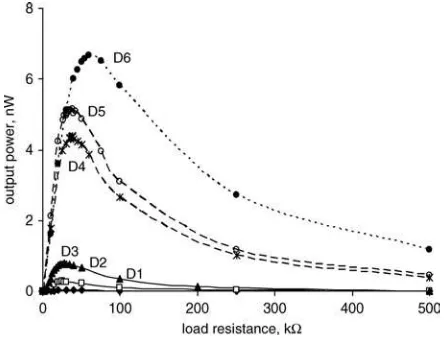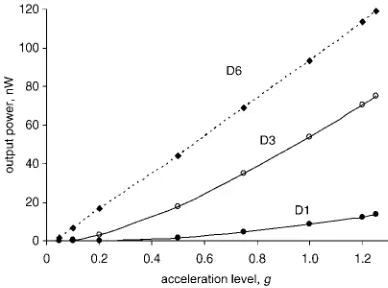Free-standing thick-film piezoelectric device
S.L. Kok, N.M. White and N.R. Harris
A free-standing thick-film cantilever sensor structure is presented. Such devices find use in applications such as vibration detection or energy harvesting. The structure was fabricated by screen printing layers of lead zirconate titanate between silver/palladium electrodes and co-firing the layers together with a carbon sacrificial layer (deposited underneath) in an air environment at a temperature of 8508C. The free-standing structure, of dimensions 18 mm long by 9 mm wide and thickness of 50mm, was found to produce electrical powers of up to 95 nW at an acceleration level of 9.81 m/s2(1g), when driving a 60 kVload resistance.
Introduction: Thick-film lead zirconate titanate (PZT) layers fabricated onto substrates such as alumina and stainless steel suffer from problems associated with the clamping effect, because the substrate material has to be accounted for, with regard to device sensitivity and frequency response. Therefore free-standing structures, in the form of cantilevers, provide improved solutions for obtaining more precise values of piezo-electric parameters such as the strain coefficient, coupling coefficient and damping ratio. Free-standing structures based on both thick and thin films as well as polymers have been reported by other researchers
[1 – 3]. In this Letter, we describe a method of fabricating screen printed free-standing thick-film cantilevers of functional materials using a one-step firing process in an air environment.
Material processing: Conventional thick-film processes were used to fabricate the structure. To make a free-standing PZT layer above the sub-strate, a carbon sacrificial layer was initially printed prior to the func-tional layers. This would subsequently be burnt out during the firing stage, thereby leaving a free-standing, sandwich structure of PZT and silver/palladium (Ag/Pd) (ESL 9633B). In addition to being used as an upper and lower electrode, the Ag/Pd plays an important role as a supporting structure for the brittle and fragile PZT ceramic. The func-tional element of the structure is made up from a mixture of PZT powder (Ferroperm Pz29) with particle sizes of 0.8 and 2mm in a ratio of 1:4, 10% by weight of lead borosilicate glass (Ferroperm CF7575) and appropriate amount of vehicle (ESL 400) to make a screen printable paste[4]. The carbon paste was made by mixing graph-ite (Sigma-Aldrich 282863) with the organic binder ethyl cellulose (Sigma-Aldrich 433837) in a ratio of 1:3. Ethyl cellulose was dissolved in terpineol (Fluka 86480) in advance before mixing with graphite and acetyl acetone together to reduce the paste viscosity [5]. Both pastes were homogenised using a triple-roll mill before screen printing on an alumina substrate.
The fabrication process was commenced by screen printing the carbon sacrificial layer. Ag/Pd was then printed over the sacrificial layer as a lower electrode (and also as supporting structure). To achieve a thickness of 50mm, four layers of PZT were printed on top of the lower electrode layer. Finally another Ag/Pd layer was again printed to function as an upper electrode. Each printed layer was dried in an infra-red dryer at 1408C for 10 min, before successive layers were printed on top. The complete printed and dried layers were then fired together in an eight-zone belt furnace, using a sintering profile with a peak temperature of 8508C (held for 10 min). This results in a total firing time of around one hour. During the firing process, the organic binder in the sacrificial layer was first burnt off and therefore the sandwich layer of electrode-PZT-electrode breaks free from the surface and begins to bend away from the substrate because of the different thermal expansion coeffi-cients between PZT ceramic and Ag/Pd. The graphite, which acted as filler in the sacrificial layer, was then burnt off totally in air as CO2 before the PZT ceramic was sintered at 8508C.
Polarisation process: Six samples of cantilevers having the same width (10 mm), but different lengths (5, 7.5, 10, 12.5, 15 and 20 mm) were fabricated. Structures having a length,L, smaller than the width, W, tended to rise at an angle of about 458away from the substrate after firing. For devices havingLW, these tended to be relatively flat and elevated to a height, H, of about 20% of the width, as shown in Fig. 1. The samples were polarised simultaneously with an electric field strength of 4.4 MVm21on a hotplate at 2008C for 30 min. The samples were then allowed to cool to room temperature before the elec-tric field was removed.
Fig. 1Photograph of PZT ceramic, free-standing structure
Results and discussion: With a careful selection of load resistance, the electrically induced damping is adjusted to be equal to mechanical damping ratio. Once the optimal load resistance is matched to the PZT free-standing device, a maximum output power will be produced. From the relation between mechanical damping ratio,z, PZT capaci-tance, C, natural frequency of the free-standing structure, vn, and optimal load resistance,Ro, the piezoelectric coupling coefficient,k31, can be calculated[6].
k31¼
Samples were tested under harmonically excited vibration on a shaker at 0.981 m/s2
(0.1g) acceleration level, and the frequency response from the free-standing devices was measured on a spectrum analyser. The measured Q-factors for the samples were between 120 and 214 and these gave damping ratio between 0.0023 and 0.0042. From (1), the piezoelectric coupling coefficient is calculated and found to be between 0.05 and 0.09.
The natural frequency dropped from about 2.2 kHz to 238 Hz for free-standing structures with length of 5 and 20 mm, respectively. At 0.1g acceleration level, structures with lengths of 18 mm produced up to 130 mV on an open-circuit test. This, however, dropped to around 20 mV with optimum load resistance at 60 kV. As the length of the free-standing structure increases, the elastic modulus Y (N/m2
) decreases, this in turn developed more strain when the same force was applied, which produced more electrical power; this agreed with the piezoelectric constitutive equations:
S¼s
YþdE; D¼1Eþds ð2Þ
whereSis mechanical strain,sis mechanical stress (N/m2), dis the piezoelectric strain coefficient (C/N), Eis electric field (N/C),D is charge density (C/m2) and1is the dielectric constant of the piezoelec-tric material (F/m).
Greater load resistances are needed for longer cantilevers in order to draw out the maximum power from the PZT layer, as shown inFig. 2. As the shaker acceleration level increased from 0.1 to 1g, the output power for sample D6 increased about ten times, as shown inFig. 3.
Fig. 2 Output power at different load resistance for samples D1 (L¼
4.5 mm), D2 (6.75 mm), D3 (9 mm), D4 (11.25 mm), D5 (13.5 mm) and D6 (18 mm), measured at 0.981 m/s2(0.1 g)
Fig. 3Output power against acceleration level
Conclusions: We have used thick-film technology to fabricate a free-standing sensor structure in the form of a cantilever. Traditional piezoelectric cantilevers are built on substrates, which cause problems associated with clamping effects and may prohibit the PZT from produc-ing optimum performance. With free-standproduc-ing structures, more accurate values of the electrical parameters of PZT films can be calculated, in addition to improving the output power when used as a vibration energy harvester. The nature of the carbon sacrificial layer, silver/ palladium electrodes and PZT ceramic needs to be further investigated, in terms of design and fabrication, to allow larger scale fabrication of flexible and robust piezoelectric free-standing devices.
Acknowledgment: A scholarship from Universiti Teknikal Malaysia Melaka and Malaysian government is gratefully acknowledged.
#The Institution of Engineering and Technology 2008 7 November 2007
Electronics Lettersonline no: 20083232 doi: 10.1049/el:20083232
S.L. Kok, N.M. White and N.R. Harris (School of Electronics and Computer Science, University of Southampton, Highfield, Southampton SO17 1BJ, United Kingdom)
E-mail: slk@soton.ac.uk
References
1 Stecher, G.: ‘Free supporting structures in thick-film technology: a substrate integrated pressure sensor’. 6th European Microelectronics Conf., Bournemouth, UK, 1987, pp. 421 – 427
2 Jeon, Y.B., Sood, R., Jeong, J., and Kim, S.-G.: ‘MEMS power generator with transverse mode thin film PZT’, Sens. Actuators A, 2005,122, pp. 16 – 22
3 Schmid, S., and Hierold, C.: ‘Two sacrificial layer techniques for the fabrication of free-standing polymer micro structures’. MicroMechanics Europe Workshop, Southampton, UK, 2006, pp. 177 – 180
4 Torah, R.N., Beeby, S.P., and White, N.M.: ‘Improving the piezoelectric properties of thick-film PZT: the influence of paste composition, powder milling process and electrode material’,Sens. Actuators A, 2004,110, pp. 378 – 384
5 Birol, H., Maeder, T., Jacq, C., Corradini, G., Passerini, R., and Fournier, Y.et al.: ‘Fabrication of LTCC micro-fluidic devices using sacrificial carbon layers’. Proc. 1st Int. Conf. Ceramic Interconnect and Ceramic Microsystems (CICMT), Baltimore, MD, US, 2005
6 Roundy, S., and Wright, P.K.: ‘A piezoelectric vibration based generator for wireless electronics’,Smart Mater. Struct., 2004,12, pp. 1131– 1142

